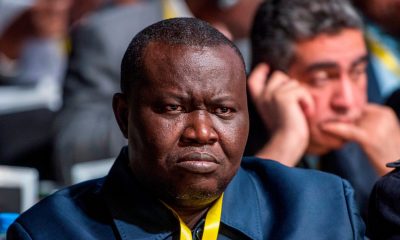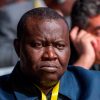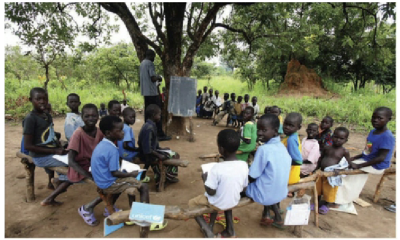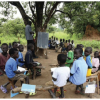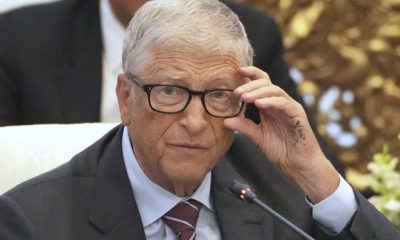News
Why Uganda’s digital school is unstoppable

On a Monday afternoon in the precincts of Lake Victoria, a casually dressed man leads a group of students, parents and teachers into a small room at a semi-rural secondary school. He picks a tablet from among the 40 laid out on long tables. With so much confidence, he starts to scroll, showing and explaining to them how to get into Biology, History, Mathematics and all the other subjects in the syllabus. He is passionate, expressive and bold. This is no ordinary man but Richard Byarugaba, the Managing Director of the National Social Security Fund (NSSF).
“We are showing you the future,” he tells his audience at Mpumudde Seed Secondary School in Jinja. “Children don’t even need to come to school. They can stay home and learn. You can even have a teacher respond to their questions via the internet. We have given you 40 tablets to start with. You can now plan to buy more”
Byarugaba is one of the most popular and influential CEOs in Uganda. After working in the banking sector for several years, he in 2010 was appointed to head the NSSF, Uganda’s retirement saving scheme for those not employed by the government. He has revolutionalised its management, customer service and, under his stewardship, the fund has grown from UGX 1.5 trillion in assets to UGX 9.98 trillion by 2018.
By spending UGX 450m to establish digital libraries in 11 government aided schools this year alone, and pledging to spend more on the same in the subsequent years, Byarugaba is, in a way, showing other corporate and government entities the direction Uganda’s education should take – digital.
The NSSF offer to the schools came in April; just two months after the National Curriculum Development Centre (NCDC) and Sensal Systems Ltd had started to roll out the digital syllabus for secondary schools.
Through a system known as Virtual Learn, students now can, with the use of customised tablets, access the entire secondary school syllabus. That means they do not need to write notes dictated by teachers as has been the practice. They can even study ahead of the teacher and do self assessment as provided for in the system.
Naturally the digital syllabus came to the more financially privileged students first – Mt St. Mary’s Namagunga, Nabisunsa Girls School, Seeta Hill SS, NdejjeSS, Namilyango Boys, St. Johns Wakiso and others – as the NCDC tablet currently costs UGX 650,000. That money is enough to cover school fees for a term for a student in an average boarding school in central Uganda. Sensal Systems Ltd, however, is already negotiating for tax waivers so that the cost of the tablet is much lower to enable more students access the system.
I was at Nabisunsa in March when the first batch of tablets was being configured and given to the more than 200 students who had paid-up by then. The excitement in the hall was enormous.
“It’s really nice. I feel extremely excited. No more copying notes,” an elated Hamida Kirose (S.6) told me then. What I found shocking, though, was that even at this top-notch school by Ugandan standards, many of the students had not been well exposed to computer prior to receiving the tablets. They didn’t for example know how to create an email account. The digital syllabus, therefore, comes along with computer literacy, a vital element in modern times.
At Kyenjojo SS in Kyenjojo district and Muni Girls School in Arua — also beneficiaries of the NSSF offer— teachers were among the most excited. Ideally they should be because this technology transforms the traditional teacher into a facilitator. This makes the job of teaching easier because students already have access to the subjects and topics. You only come in to guide them.
Kenya in 2016 piloted its digital literacy programme in primary schools and a year later school enrolment had gone up, absenteeism had reduced and interactivity between teachers and learners was reported to have increased. In Kyenjojo, one teacher expressed that with the tablets, their school was bound to attract more students.
By now over 3000 students in Uganda have access to the secondary school syllabus through personal tablets. The NSSF initial offer is estimated to benefit at least 5000 students in the 11 schools spread across the different regions of Uganda.

Sensal Systems ltd, the developers of Virtual Learn, say that by October 2019 several other learning tools, including e-books, STEM laboratory, ex-prep, Assessment Engine and others, will have been added to the system and students can access them through the tablets.
Ivan Mukasa Ssensalire, the Project Manager told me this week: “The e-book is going to contain some interactive books, the quality of the first world – US, Singapore, Japan, UK, Canada, German.” In these students will find innovative animations to enhance their learning and problem solving.
The Sensal Virtual Lab, which is a digital laboratory meant especially to help science students with limited access to the physical laboratory, as well as the Virtual Learn system for primary schools, are also expected by the end of 2019.
Observing from the schools I have been to, student’s attitude to digital tools for learning is extremely positive – and their parents too because it is all about moving with modernity.When CEOs such as Byarugaba start to not only campaign for but also donate towards digital in Uganda’s education, you realise how important it is for today’s learner. What we need now is a national discussion on two key issues: 1) How to help every child access digital and modern learning tools; 2) how to get the teacher and the learner into an environment suitable for learning in modern times?
Below is a quote from John Phillips, Advisor E-Business, Dell Technologies, which I picked from a post on the website of EdSurge, a leading educational technology company in the US, on what a modern classroom should look like:
“First, a modern classroom is actually messy. It’s loud and it’s fun. The other thing that I see that is starting to really cascade around the globe is related to teachers. You may peek in the room, and you may not be able to see them. Where’s the teacher? Oh, the teacher is over there.”
I am looking forward to the discussion.
The writer is the President, Uganda Science Journalists Association (USJA)
Comments









